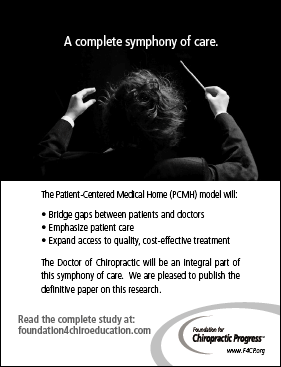Apparently the American Medical Association and American Academy of Family Physicians are taking the word medical in "medical home model" quite literally, at least if their interest in publishing a Foundation for Chiropractic Progress advertisement on the topic of the medical home is any indication.
Archives: "Thank you for your inquiry regarding classified advertising in publications of the American Medical Association (AMA). Upon considered review, your submission has been declined. The AMA, in its sole discretion, reserves the right to decline any submitted advertisement or to discontinue publication of any advertisement previously accepted. We appreciate your understanding of this matter."
 AFP: "While advertisements in American Family Physician do not represent an endorsement by the AAFP or the journal, we are nevertheless obligated by our membership to ensure that advertisements are in harmony with the mission and purpose of the journal. After careful review of both the advertisement and the supporting research documentation, and upon the recommendation of our review panel of family physicians, I regret that we are notable to accept this advertisement in AFP. We sincerely thank you for considering AFP, and wish you all the best."
AFP: "While advertisements in American Family Physician do not represent an endorsement by the AAFP or the journal, we are nevertheless obligated by our membership to ensure that advertisements are in harmony with the mission and purpose of the journal. After careful review of both the advertisement and the supporting research documentation, and upon the recommendation of our review panel of family physicians, I regret that we are notable to accept this advertisement in AFP. We sincerely thank you for considering AFP, and wish you all the best."
"We are shocked and outraged by the actions of two medical journals in refusing to publish our ad regarding the role of chiropractors in the medical home model – particularly the decision by the AMA journal Archives of Internal Medicine," commented Laura Carabello, founder and principal of CPR Communications, the foundation's PR agency. "Improving communications between health care groups should be a common goal, and one would think 20 years following the Wilk v AMA decision, this kind of attitude would no longer exist. What are they afraid of?"
By the way, the foundation submitted the same ad to several other health care publishers, including the Medical Group Management Association, Modern Healthcare, AIS Health, Employee Benefit News and HealthLeaders – all of which accepted the ad for publication and scheduled it to run in e-newsletters, e-blasts and/or online beginning in late November. The ad also appeared in the Nov. 1 print issue of The Wall Street Journal.
The advertisement features an image of an orchestra conductor, back turned, under the header: "A complete symphony of care." Below the image, it states that the patient-centered medical home model will accomplish the following:
- Bridge gaps between patients and doctors
- Emphasize patient care
- Expand access to quality, cost-effective treatment
 The ad then notes, "The Doctor of Chiropractic will be an integral part of this symphony of care. We are pleased to publish the definitive paper on this research," and directs readers to review the "complete study" online at www.foundation4chiroeducation.com. That research, of course, includes "The Role of Chiropractic Care in the Patient-Centered Medical Home," which details how doctors of chiropractic can function as vital team members within the medical home model. (One assumes that DCs would likewise function well in Affordable Care Organizations based on the same premise, which would help ACO participants from all disciplines – AMA / AAFP members included – share in the cost savings to Medicare achieved by accountable care.) One wonders how an ad promoting chiropractic participation and cooperation in achieving the above would be considered incompatible with "the mission and purpose" of the journals.
The ad then notes, "The Doctor of Chiropractic will be an integral part of this symphony of care. We are pleased to publish the definitive paper on this research," and directs readers to review the "complete study" online at www.foundation4chiroeducation.com. That research, of course, includes "The Role of Chiropractic Care in the Patient-Centered Medical Home," which details how doctors of chiropractic can function as vital team members within the medical home model. (One assumes that DCs would likewise function well in Affordable Care Organizations based on the same premise, which would help ACO participants from all disciplines – AMA / AAFP members included – share in the cost savings to Medicare achieved by accountable care.) One wonders how an ad promoting chiropractic participation and cooperation in achieving the above would be considered incompatible with "the mission and purpose" of the journals.
Also featured on the foundation Web site as research support of chiropractic's effectiveness in the medical home / ACO model – and the health care system in general – are the following (among other citations), many of which readers will recognize from previous reference in DC:
Choudhry, et al.: "Do Chiropractic Physician Services for the Treatment of Low Back and Neck Pain Improve the Value of Health Benefit Plans?" According to the authors, "When considering effectiveness and cost together, chiropractic physician care for low back and neck pain is highly cost-effective, [and] represents good value in comparison to medical physician care and to widely accepted cost-effectiveness thresholds. Because we were unable to incorporate savings in drug spending commonly associated with US chiropractic care, our estimate of its comparative cost effectiveness is likely to be understated."
Cifuentes, et al.: "Health Maintenance Care in Work-Related Low Back Pain and Its Association With Disability Recurrence," which determined: "In work-related nonspecific LBP, the use of health maintenance care provided by physical therapist or physician services was associated with a higher disability recurrence than in chiropractic services or no treatment."
McMorland, et al.: "Manipulation or Microdiskectomy for Sciatica? A Prospective, Randomized Clinical Study," which concluded: "Sixty percent of patients with sciatica who had failed other medical management benefited from spinal manipulation to the same degree as if they underwent surgical intervention. Of 40% left unsatisfied, subsequent surgical intervention confers excellent outcome. Patients with symptomatic LDH failing medical management should consider spinal manipulation followed by surgery if warranted."
Sarnat, et al.: "Clinical Utilization and Cost Outcomes From an Integrative Medicine Independent Physician Association," which found that "CAM-oriented PCPs using a nonsurgical/nonpharmaceutical approach demonstrated reductions in both clinical and cost utilization when compared with PCPs using conventional medicine alone."




